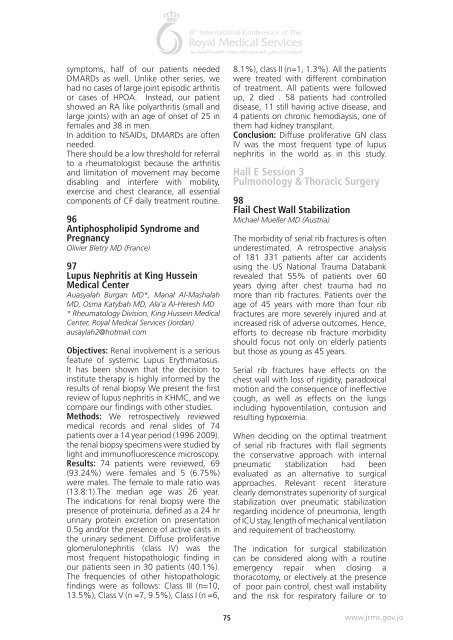Abstract book 6th RMS 16.indd
Abstract book 6th RMS 16.indd
Abstract book 6th RMS 16.indd
Create successful ePaper yourself
Turn your PDF publications into a flip-book with our unique Google optimized e-Paper software.
symptoms, half of our patients needed<br />
DMARDs as well. Unlike other series, we<br />
had no cases of large joint episodic arthritis<br />
or cases of HPOA. Instead, our patient<br />
showed an RA like polyarthritis (small and<br />
large joints) with an age of onset of 25 in<br />
females and 38 in men.<br />
In addition to NSAIDs, DMARDs are often<br />
needed.<br />
There should be a low threshold for referral<br />
to a rheumatologist because the arthritis<br />
and limitation of movement may become<br />
disabling and interfere with mobility,<br />
exercise and chest clearance, all essential<br />
components of CF daily treatment routine.<br />
96<br />
Antiphospholipid Syndrome and<br />
Pregnancy<br />
Olivier Bletry MD (France)<br />
97<br />
Lupus Nephritis at King Hussein<br />
Medical Center<br />
Auasyalah Burgan MD*, Manal Al-Mashalah<br />
MD, Osma Katybah MD, Ala’a Al-Heresh MD<br />
* Rheumatology Division, King Hussein Medical<br />
Center, Royal Medical Services (Jordan)<br />
ausaylah2@hotmail.com<br />
Objectives: Renal involvement is a serious<br />
feature of systemic Lupus Erythmatosus.<br />
It has been shown that the decision to<br />
institute therapy is highly informed by the<br />
results of renal biopsy We present the first<br />
review of lupus nephritis in KHMC, and we<br />
compare our findings with other studies.<br />
Methods: We retrospectively reviewed<br />
medical records and renal slides of 74<br />
patients over a 14 year period (1996‐2009).<br />
the renal biopsy specimens were studied by<br />
light and immunofluorescence microscopy.<br />
Results: 74 patients were reviewed, 69<br />
(93.24%) were females and 5 (6.75%)<br />
were males. The female to male ratio was<br />
(13.8:1).The median age was 26 year.<br />
The indications for renal biopsy were the<br />
presence of proteinuria, defined as a 24 hr<br />
urinary protein excretion on presentation<br />
0.5g and/or the presence of active casts in<br />
the urinary sediment. Diffuse proliferative<br />
glomerulonephritis (class IV) was the<br />
most frequent histopathologic finding in<br />
our patients seen in 30 patients (40.1%).<br />
The frequencies of other histopathologic<br />
findings were as follows: Class III (n=10,<br />
13.5%), Class V (n =7, 9.5%), Class I (n =6,<br />
8.1%), class II (n=1, 1.3%). All the patients<br />
were treated with different combination<br />
of treatment. All patients were followed<br />
up, 2 died . 58 patients had controlled<br />
disease, 11 still having active disease, and<br />
4 patients on chronic hemodiaysis, one of<br />
them had kidney transplant.<br />
Conclusion: Diffuse proliferative GN class<br />
IV was the most frequent type of lupus<br />
nephritis in the world as in this study.<br />
Hall E Session 3<br />
Pulmonology & Thoracic Surgery<br />
98<br />
Flail Chest Wall Stabilization<br />
Michael Mueller MD (Austria)<br />
The morbidity of serial rib fractures is often<br />
underestimated. A retrospective analysis<br />
of 181 331 patients after car accidents<br />
using the US National Trauma Databank<br />
revealed that 55% of patients over 60<br />
years dying after chest trauma had no<br />
more than rib fractures. Patients over the<br />
age of 45 years with more than four rib<br />
fractures are more severely injured and at<br />
increased risk of adverse outcomes. Hence,<br />
efforts to decrease rib fracture morbidity<br />
should focus not only on elderly patients<br />
but those as young as 45 years.<br />
Serial rib fractures have effects on the<br />
chest wall with loss of rigidity, paradoxical<br />
motion and the consequence of ineffective<br />
cough, as well as effects on the lungs<br />
including hypoventilation, contusion and<br />
resulting hypoxemia.<br />
When deciding on the optimal treatment<br />
of serial rib fractures with flail segments<br />
the conservative approach with internal<br />
pneumatic stabilization had been<br />
evaluated as an alternative to surgical<br />
approaches. Relevant recent literature<br />
clearly demonstrates superiority of surgical<br />
stabilization over pneumatic stabilization<br />
regarding incidence of pneumonia, length<br />
of ICU stay, length of mechanical ventilation<br />
and requirement of tracheostomy.<br />
The indication for surgical stabilization<br />
can be considered along with a routine<br />
emergency repair when closing a<br />
thoracotomy, or electively at the presence<br />
of poor pain control, chest wall instability<br />
and the risk for respiratory failure or to<br />
75 www.jrms.gov.jo

















